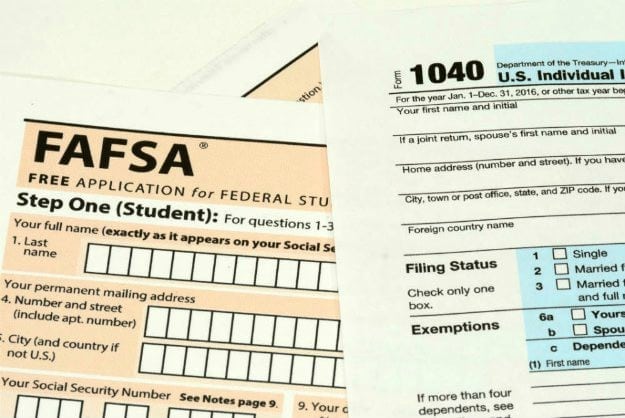The average college student leaves university with two things: a bachelor’s degree and around $20,000 in student loans. As a result, many college graduates struggle to make ends meet just to pay off their debt.
Luckily, applying for FAFSA student loans is a great way to determine whether you’re eligible for student aid. With the right knowledge, you can successfully apply for FAFSA student loans and take the first step toward a debt-free life.
(Bonus Tip: Are you a recent graduate with a hefty handful of loans? If so, you are probably wondering what the next best step is for managing them after graduation. Not a worry! Skip the confusion and check out this super-equipped Graduate’s Guide To Student Loans and find out how you can easily understand your finances, here.)
FAFSA Student Loans: 7 Things to Know This 2018
In this article:
-
- What is the FAFSA Student Loans Form?
- When is the Deadline for Passing the FAFSA Student Loans Form This A.Y. 2018–2019?
- 3 Types of Aid Available
- The Early Bird Catches the Worm
- The Time Shift
- State and Institutional Deadlines
- Eligibility
1. What is the FAFSA Student Loans Form?
The FAFSA student loans form, or Free Application for Federal Student Aid, is the form candidates submit to determine their eligibility for financial aid.
Nearly every student (and prospective college student) qualifies for some form of financial aid.
2. When is the Deadline for Passing the FAFSA Student Loans Form This A.Y. 2018–2019?
Students can begin submitting their FAFSA student loan form October 1, 2017. However, you can submit the form up to June 30, 2019.
Also, you have to file the FAFSA only once to determine your eligibility for all three types of aid.
3. 3 Types of Aid Available
Three types of aid are available: federal, state, and institutional aid.
- Federal: Every year, the federal government provides billions of dollars of financial aid in the form of grants. Because these are grants, they don’t have to be repaid.
- State: Your FAFSA student loans form is also submitted to your state education agency responsible for providing your community with state aid. Often, you will qualify for state grants and scholarships only in the state in which you reside.
- Institutional Aid: Institutional aid is provided by the institutions to which you apply. However, you will still have to pass the FAFSA student loans form to qualify for the grants that various institutions in the country provide.
4. The Early Bird Catches the Worm

While you have almost a year to file your FAFSA student loans form, you should aim to submit the form as close to the opening date (in this case, October 1, 2017) as possible. By doing so, you’ll have a better chance of qualifying for the various major grants that are always in demand.5. The Time Shift
In earlier years, the submission of FAFSA student loans forms often opened during the first months of the year.
However, since last year, the FAFSA opened the submission process later in the year. This means students applying for the FAFSA this academic year have much more time to prepare their requirements even earlier.
(Pro Tip: Are you looking for a one-stop shop that covers all the basic elements of student loans? We’ve got you covered! From the breakdown of common terms, to understanding your own personal loans, the 2018 Grad’s Guide To Student Loans will explain everything that you need to know in the most simple way possible. Click to get your free guide, here.)
6. State and Institutional Deadlines
While they are under the FAFSA student loans forms, state and institutional deadlines are often different from the deadlines that the federal government sets. This means states and institutions can set deadlines earlier, or even later, than the federal government’s deadline. Therefore, students must be careful to ensure that they meet their respective states’ and institutions’ deadlines.
7. Eligibility
The last thing you must consider before submitting your FAFSA student loans application form is your eligibility.
An SSS and a high school diploma are just some of the things you need to apply for financial aid. For a complete list of requirements, check out the official FAFSA website.
FAFSA includes all types of federal student aid. This includes grants, loans, and work-study eligibility. pic.twitter.com/tbfsJv4dwF
— Penn State SFEC (@PennStateSFEC) February 12, 2018
Check out this video by Federal Student Aid to learn more about FAFSA student loans:
Overall, submitting a FAFSA student loans application form early is the best way to receive financial support for your college education.
Make sure to note the FAFSA opening and deadline so you can efficiently prepare your requirements. Pass your FAFSA student loans form today so you can take the first step toward removing the burden of student loan debt.
(Pro Tip: Are you looking for a one-stop shop that covers all the basic elements of student loans? We’ve got you covered! From the breakdown of common terms, to understanding your own personal loans, the 2018 Grad’s Guide To Student Loans will explain everything that you need to know in the most simple way possible. Click to get your free guide, here.)
Did reading this article give you an idea of how FAFSA student loans work? Feel free to share your thoughts with us in the comments section below this page. We would love to hear from you!
Up Next: How to Get Your Lender to Forgive Student Loan Debt


Leave a Reply